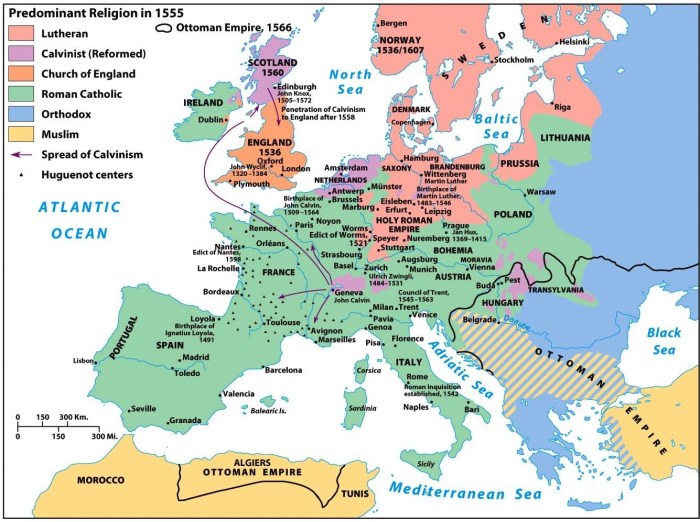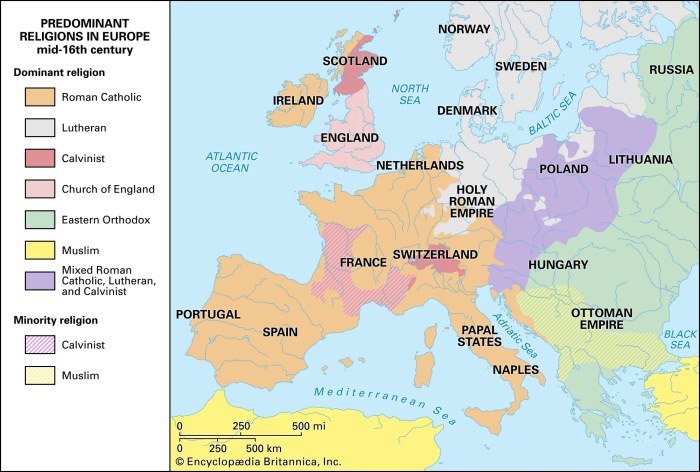Map of the protestant reformation – Embark on a cartographic exploration of the Protestant Reformation, a pivotal era that reshaped the religious landscape of Europe. This map chronicles the spread of Protestantism, tracing its origins from Martin Luther’s Ninety-Five Theses to its profound impact on European society and politics.
Delve into the factors that ignited the Reformation, the key figures who drove its expansion, and the Catholic Church’s response to this transformative movement. Witness the rise of Protestant denominations, the redrawing of political boundaries, and the enduring legacy of the Reformation on religious thought and practice.
Historical Context: Map Of The Protestant Reformation

Before the Reformation, Europe was a predominantly Catholic continent. The Catholic Church held immense power and influence, controlling both religious and political life. However, a number of factors contributed to the rise of Protestantism, including:
- Growing dissatisfaction with the Catholic Church’s practices, such as the sale of indulgences and the perceived corruption of the clergy.
- The rise of humanism and the rediscovery of ancient Greek and Roman texts, which emphasized reason and individualism.
- The invention of the printing press, which allowed for the widespread dissemination of new ideas.
Martin Luther and the Ninety-Five Theses
Martin Luther, a German monk, is widely regarded as the father of the Protestant Reformation. In 1517, he published his Ninety-Five Theses, which challenged the Catholic Church’s authority on issues such as salvation and the role of the clergy. Luther’s ideas resonated with many people who were disillusioned with the Catholic Church, and they quickly spread throughout Europe.
The Ninety-Five Theses had a profound impact on the religious landscape of Europe. They sparked a debate that led to the formation of new Protestant denominations, such as Lutheranism and Calvinism. Luther’s ideas also contributed to the rise of religious toleration and the development of modern nation-states.
Spread of Protestantism
Protestantism spread rapidly throughout Europe in the 16th and 17th centuries. Key figures in this expansion included John Calvin, who founded Calvinism, and Henry VIII, who established the Church of England. The spread of Protestantism was also aided by the political and social turmoil of the time, such as the wars of religion in France and the Thirty Years’ War.
Protestantism had a significant impact on the political and social landscape of Europe. It led to the rise of religious pluralism and the decline of the Catholic Church’s power. Protestantism also contributed to the development of modern science and education, as well as the rise of capitalism.
Catholic Reformation, Map of the protestant reformation
The Catholic Church responded to the Reformation with a series of reforms known as the Catholic Reformation. These reforms included the establishment of new religious orders, such as the Jesuits, and the implementation of new practices, such as the Council of Trent.
The Catholic Reformation helped to slow the spread of Protestantism and to strengthen the Catholic Church.
The Catholic Reformation had a significant impact on the development of Protestantism. It led to a hardening of religious divisions and the outbreak of religious wars. The Catholic Reformation also contributed to the development of new forms of Catholic piety and spirituality.
Query Resolution
What were the key factors that contributed to the rise of Protestantism?
Political grievances, social unrest, and the desire for religious reform played significant roles.
How did Martin Luther’s Ninety-Five Theses spark the Reformation?
Luther’s critique of the Catholic Church’s practices and doctrines ignited a debate that spread rapidly throughout Europe.
What was the impact of the Catholic Reformation on Protestantism?
The Catholic Church’s response, including reforms and the Council of Trent, aimed to strengthen Catholicism and counter the spread of Protestantism.
